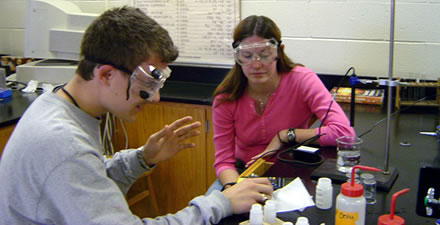Biotechnology Student Notes
Unit I:
Introduction to Biotechnology
Biotechnology is the use of living organisms to solve problems or make useful products.
Biotechnology is used for:
- Human health
- Disease diagnosis, treatment and prevention
- Agriculture
- Environment - bioremediation, energy sources
Prior to Biotechnology, man domesticated plants and animals for 10,000 years: nitrogen fixing plants, bread, wine, cheese, yogurt, antibiotics from microbes, enzymes for cleaning clothes, control insect pests, sewage treatment, and vaccines. General categories of biotechnology include: monoclonal antibody technology (MCAb), Bioprocessing, Genetic Engineering, Medical Biotechnology, Designer Drugs, Gene Therapy, Cancer Treatments, Vaccines and Agricultural uses.
- Monoclonal Antibody technology (MCAb):
Monoclonal antibody technology: a sensitive diagnostic tool used to detect specific substances in blood or urine. The specificity of the reaction of a monoclonal antibody with a specific antigen enables the detection of a pregnancy or a cancer. Monoclonal antibodies are obtained from B lymphocytes, a type of white blood cell. White blood cells can be eosinophiles, basophil, neutrophils, monocytes or lymphocytes. These all fight infections. Lymphocytes can be either T Lymphocytes (T cells) or B Lymphocytes (B cells) which produce immune responses against foreign substances. B lymphocytes make Antibodies (Ab) and as such can be used as tools for detection, quantification and localization of disease and medical treatments. Scientific measurements based on MCAb are faster, more accurate and more sensitive due to the specificity of the antibody to the individual antigen. Some uses of MCAb are:
- Home pregnancy kits
- Strep throat
- Gonorrhea
- Cancer: technology to tag tumors with a radioisotope or toxin is being developed. Specificity allows the isotope or toxin to bypass normal cells, reducing negative side effects in patients.
- Detect disease in plants and animals
- Bioprocessing:
The use of enzymes.
- Fermentation: bread, wine, beer, yogurt, vinegar
- Biodegradation: used to clean up the environment as in oil spills, and toxic waste
- Exxon Valdez in Alaska's Prince William Sound in 1989
- Toxic waste: Superfund is one of America's most important public health protection laws, arsenic site in the East Phillips community of Minneapolis is being investigated and cleaned up with superfunds.
- Cell Tissue and Culture technology:
- Plant tissue culture - essential to plant biotechnology
- Animal Cell Culture: viruses as biological control agents and used in livestock breeding
- Test drugs and viruses
- Provide a mechanism for producing large quantities of cellular compounds
- Produce functional tissue lost by disease or accident, ears, nose
- Biosensor technology: measure substances at very low concentrations - for freshness and safety of food
- Genetic Engineering Technology
- Selective Breeding for plants or animals: single gene or sets of genes
- Novel Genetic Variation: Bt (Bacillus thuringiensis); the gene for a protein, delta endotoxin, which is toxic to crop pests is put into tobacco, tomato, cotton, potato and corn plants to prevent infestation.
- Protein Engineering: enzymes for manufacturing, for catalyst
- Abzymes: antibodies that resemble enzymes with catalytic activities, including reactions that do not normally use enzymes
- Antisense technology: blocks or decreases production of certain proteins i.e. the use of small nucleic acids that prevent translation of DNA into protein. For example, this technology is used to prevent food spoilage, control viral disease and to treat cancers with a genetic basis.
- Medical Biotechnology
- Diagnostics: Home pregnancy kits, Strep throat, Gonorrhea tests use DNA probes, RFLPs (Restriction fragment length polymorphisms) and PCR (polymnerase chain reaction) technologies.
- Therapeutics: pharmaceuticals from plants, examples include:
- digitalis from the foxglove plant is used to treat heart patients
- the Madagascar periwinkle is used to treat patients with leukemia and nonHodgkins lymphoma
- taxol from Yew trees is used to treat breast cancer
- Endogenous therapeutic agents: body's own therapeutic compounds, many proteins are good candidates for genetic engineering; the future will focus on the body's innate healing abilities.
- Interleukin 2 activates T cell responses good for certain cancers produced by genetically engineered bacteria (used for brain cancer)
- Erythropoietin: regulates RBC production and is successful in treating anemia
- Tissue plasminogen activator produced by genetically engineered bacteria dissolves blood clots.
- Growth Factors appear to be related to nerve diseases
- Designer Drugs: using computer modeling and protein engineering
- Replacement therapies for inadequate production from defective genes
- Factor VIII protein for hemophiliacs
- Growth Hormone Dwarfism
- Insulin protein that regulates blood glucose levels
- Gene Therapy isolates and clones genes
- Immune system deficiency (adenosine deaminase deficiency, ADA); if not produced toxins build up ex. Bubble boy
- Kidney disease
- Ovarian cancer gene (thymidine kinase)
- Cystic fibrosis gene
- Cancer Therapies
- Immunosuppressive therapies: MCAb
- Vaccines: flu, small pox
- Medical Research Tools
- Agricultural Biotechnology: GMO genetically manufactured organisms)
- Societal Issues: Bioethics need to be addressed
- Genetic testing
- Genetic Screening
- Genetic Information
- Genetic Privacy
- Insurance Issues
- Employment Issues
References and Resources:
Lehninger, "Biochemistry"
Sheenan, M. "Biochemistry and Molecular Biology", University of Bath 16-19 Series, Nelson, 1994 ISBN 0 17 4482078
Barnum, Susan R. "Biotechnology"Kruezer, Helen, "Recombinant DNA and Biotechnology" Laboratory Resource Materials City Lab Curriculum from Boston University in conjunction with UNC-Chapel Hill Department of Biology
NIH Curriculum Supplement Series including Human Genetic Variation, Cell Biology and Cancer, The Brain: Understanding Neurobiology through the Study of Addiction

